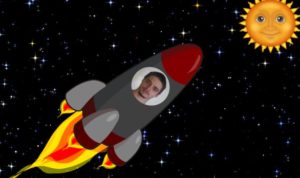Student touches the Sun
Joerassic Park
Memesonian Creative Editor

We humans have been to every major celestial body, except for one: the Sun. NASA is working on a mission to fix that. They want to “Touch the Sun.”
“The only reason we haven’t gone to the sun yet is because it’s too hot,” NASA officials stated. “They plan to launch a rocket sometime between July 31 and Aug. 19 of this year. They even plan to send people on this mission.”
One of our very own Vikings is going on the 93-million-mile trip.
“I’ve always wanted to go into outer space,” said individual studies major Joseph Lyle. “I have plans to go to Mars in May as well.”
The Sun’s surface is almost 10,000 degrees and is primarily burning plasma. The purpose of this mission is to explore the Sun’s outer atmosphere at about four million miles above the surface.
NASA claims they have solved the heat problem after decades of research.
“We will simply go to the Sun at night,” said lead scientist Richard Morton. “At night, the surface of the sun is a balmy 800 degrees.”
The small spacecraft will have a heat shield pointed at the Sun to aid in protecting itself from the heat. The craft will also face radiation like no other craft in history. The data this mission will supply will aid in our understanding of the physics of how stars work and improve the forecast of major space weather events.
Many individuals would be terrified to go on a mission such as this.
“I’m not scared,” Lyle said. “I have dreamed of going into space, and now I finally get to fulfill this dream.”
Lyle mentioned he would pack a big lunch of Sun Chips, sunflower seeds and Capri Sun. The morning of the launch, he will be having eggs… sunny side up.
“A lot of my inspiration comes from things I have seen in movies — that is why when I go to Mars, I am bringing potatoes,” Lyle said, before thanking Mark Watney.
The spacecraft will be launched from NASA’s Kennedy Space Center in Florida, on top of a Delta IV-Heavy with Upper Stage.
“This will be a huge accomplishment for America,” said President Donald Trump. “This is what is going to make America great in space again. First the Sun, then the Solar System.”
Overall, this mission will provide scientists with much-needed data about our closest star. The science we will gain from the Sun will exceed what scientists hope to gather. This is truly the first step to being able to not only understand our sun, but to also answer any questions we have about the universe.
Aboard the spacecraft, dubbed the Parker Solar Probe, will be a microchip. This microchip will contain the names of people who have registered with NASA to voyage to the Sun. Though these individuals are unable to go in person, their names will be able to take the trek and live on in history as they orbit the Sun.
“My disability prevents me from doing the amazing things I want to do, such as go into space,” Lyle said. “Thanks to NASA, my name is able to go. For me, that is good enough.”
He compared it to when someone buys a star. To this individual, the star is his or her own. To the rest of the world, however, that star is just a ball of fire in the night sky.
